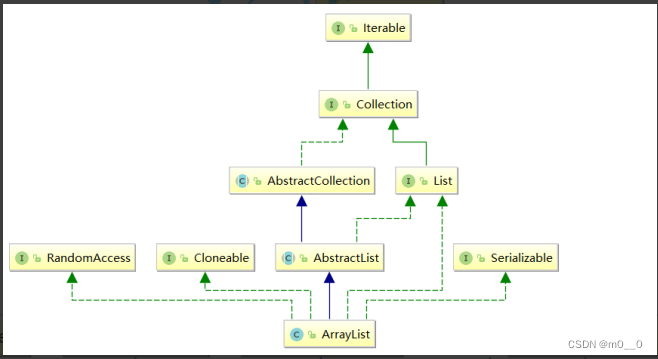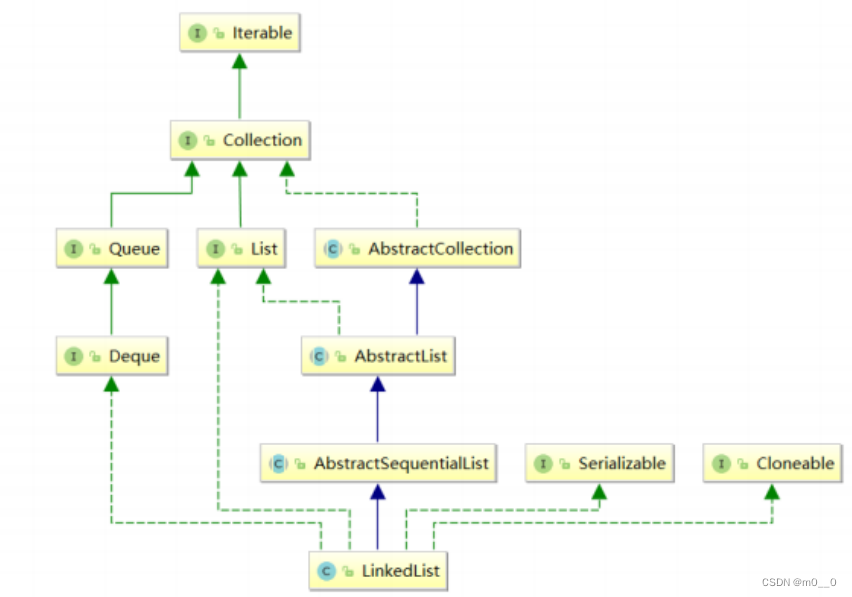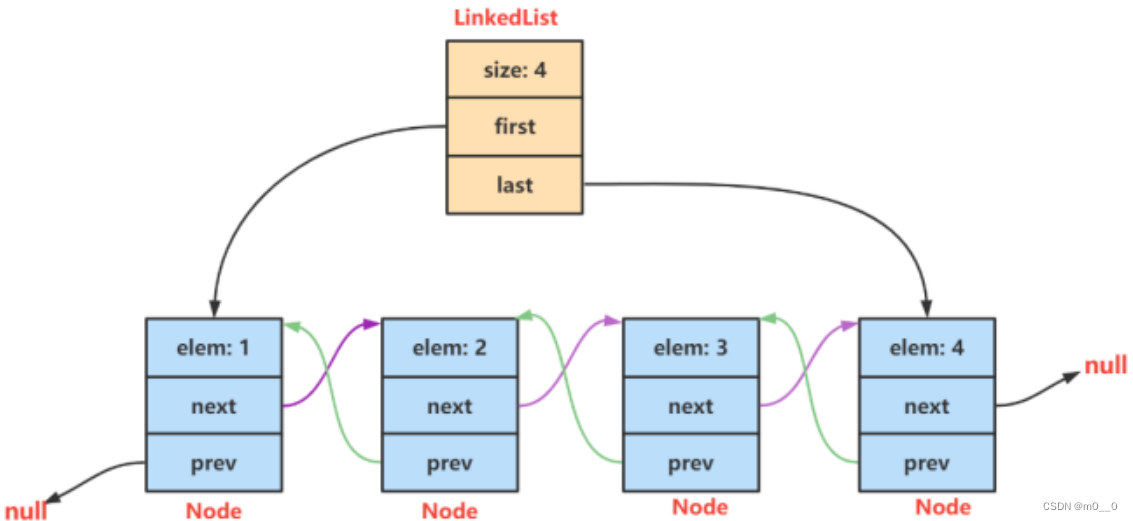一、ArrayList
1.ArrayList简介
在集合框架中,ArrayList是一个普通的类,实现了List接口,具体框架图如下:

【
说明】
1. ArrayList是以泛型方式实现的,使用时必须要先实例化
2. ArrayList实现了RandomAccess接口,表明ArrayList支持随机访问
3. ArrayList实现了Cloneable接口,表明ArrayList是可以clone的
4. ArrayList实现了Serializable接口,表明ArrayList是支持序列化的
5. 和Vector不同,ArrayList不是线程安全的,在单线程下可以使用,在多线程中可以选择Vector或 者CopyOnWriteArrayList
6. ArrayList底层是一段连续的空间,并且可以动态扩容,是一个动态类型的顺序表
2.顺序表
顺序表是用一段
物理地址连续的存储单元依次存储数据元素的线性结构,一般情况下采用数组存储。在数组上完成 数据的增删查改。
3.ArrayList的扩容机制
截取ArrayList源码
private static final int MAX_ARRAY_SIZE = Integer.MAX_VALUE - 8;
private void grow(int minCapacity) {
// 获取旧空间大小
int oldCapacity = elementData.length;
// 预计按照1.5倍方式扩容
int newCapacity = oldCapacity + (oldCapacity >> 1);
// 如果用户需要扩容大小 超过 原空间1.5倍,按照用户所需大小扩容
if (newCapacity - minCapacity < 0)
newCapacity = minCapacity;
// 如果需要扩容大小超过MAX_ARRAY_SIZE,重新计算容量大小
if (newCapacity - MAX_ARRAY_SIZE > 0)
newCapacity = hugeCapacity(minCapacity);
// 调用copyOf扩容
elementData = Arrays.copyOf(elementData, newCapacity);
}
private static int hugeCapacity(int minCapacity) {
// 如果minCapacity小于0,抛出OutOfMemoryError异常
if (minCapacity < 0)
throw new OutOfMemoryError();
return (minCapacity > MAX_ARRAY_SIZE) ? Integer.MAX_VALUE : MAX_ARRAY_SIZE;
}
【
总结】
1. 检测是否真正需要扩容,如果是调用grow准备扩容
2. 预估需要库容的大小
初步预估按照1.5倍大小扩容
如果用户所需大小超过预估1.5倍大小,则按照用户所需大小扩容
真正扩容之前检测是否能扩容成功,防止太大导致扩容失败
3. 使用copyOf进行扩容
4.ArrayList的缺陷
由于其底层是一段连续空间,当 在 ArrayList 任意位置插入或者删除元素时,就需要将后序元素整体往前或者往后 搬移,时间复杂度为 O(n),效率比较低,因此 ArrayList 不适合做任意位置插入和删除比较多的场景。因此:java 集合中又引入了LinkedList,即链表结构。
二·、LinkedList
LInkedList本质就是一个链表!!!
2.1 链表的概念及结构
链表是一种物理存储结构上非连续存储结构,数据元素的逻辑顺序是通过链表中的引用链接次序实现的 。

2.2 什么是LinkedList
LinkedList的底层是双向链表结构(链表后面介绍),由于链表没有将元素存储在连续的空间中,元素存储在单独的节 点中,然后通过引用将节点连接起来了,因此在在任意位置插入或者删除元素时,不需要搬移元素,效率比较高。


【说明】
1. LinkedList实现了List接口
2. LinkedList的底层使用了双向链表
3. LinkedList没有实现RandomAccess接口,因此LinkedList不支持随机访问
4. LinkedList的任意位置插入和删除元素时效率比较高,时间复杂度为O(1)
5. LinkedList比较适合任意位
2.3 LinkedList模拟实现
public class MyLinkedList {
static class ListNode {
public int val;
ListNode prev;
ListNode next;
public ListNode(int val) {
this.val = val;
}
}
public ListNode head;
public ListNode last;
//头插法 O(1)
public void addFirst(int data){
ListNode node = new ListNode(data);
if (head == null) {
head = node;
last = node;
}else {
node.next = head;
head.prev = node;
head = node;
}
}
//尾插法 O(1)
public void addLast(int data){
ListNode node = new ListNode(data);
if (head == null) {
head = node;
last = node;
}else {
last.next = node;
node.prev = last;
last = node;
}
}
//任意位置插入,第一个数据节点为0号下标
public void addIndex(int index,int data){
if (index < 0 || index >size()) {
throw new CheckOutOfException("位置被合法");
//return;
}
if (index == 0) {
addFirst(data);
return;
}
if (index == size()) {
addLast(data);
return;
}
ListNode cur = findIndex(index);
ListNode node = new ListNode(data);
node.next = cur;
cur.prev.next = node;
node.prev = cur.prev;
cur.prev = node;
}
public ListNode findIndex(int index) {
ListNode cur = head;
while (index != 0) {
cur = cur.next;
index--;
}
return cur;
}
//查找是否包含关键字key是否在链表当中
public boolean contains(int key){
ListNode cur = head;
while (cur != null) {
if (cur.val == key) {
return true;
}
cur = cur.next;
}
return false;
}
//删除第一次出现关键字为key的节点
public void remove(int key){
ListNode cur = head;
while (cur != null) {
if (cur.val == key) {
//1.删除的是头节点
if (cur == head) {
head = head.next;
//处理只有一个节点
if (head != null) {
head.prev = null;
}
}else {
//中间 尾巴
cur.prev.next = cur.next;
//不是尾巴节点
if (cur.next != null) {
cur.next.prev = cur.prev;
}else {
//是尾巴节点
last = cur.prev;
}
}
return;
}
cur = cur.next;
}
}
//删除所有值为key的节点 O(n)
public void removeAllKey(int key){
ListNode cur = head;
while (cur != null) {
if (cur.val == key) {
//1.删除的是头节点
if (cur == head) {
head = head.next;
//处理只有一个节点
if (head != null) {
head.prev = null;
}
}else {
//中间 尾巴
cur.prev.next = cur.next;
//不是尾巴节点
if (cur.next != null) {
cur.next.prev = cur.prev;
}else {
//是尾巴节点
last = cur.prev;
}
}
}
cur = cur.next;
}
}
//得到链表的长度
public int size(){
int len = 0;
ListNode cur = head;
while (cur != null) {
len++;
cur = cur.next;
}
return len;
}
//打印链表
public void display(){
ListNode cur = head;
while (cur != null) {
System.out.print(cur.val+" ");
cur = cur.next;
}
System.out.println();
}
}
总结:
| 不同点 | ArrayList | LinkedList |
| 存储空间上 | 物理上一定连续 | 逻辑上连续,但物理上不一定连续 |
| 随机访问 | 支持O(1) | 不支持:O(N) |
| 头插 | 需要搬移元素,效率低O(N) | 只需修改引用的指向,时间复杂度O(1) |
| 插入 | 空间不够时需要扩容 | 没有扩容概念 |
| 应用场景 | 元素高效存储+频繁问 | 任意位置插入和删除频繁 |





















 1404
1404











 被折叠的 条评论
为什么被折叠?
被折叠的 条评论
为什么被折叠?








